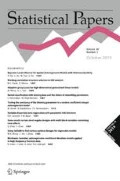Abstract
The equivalence of ordinary least squares estimators (OLSE) and Gauss–Markov estimators for models with variance–covariance matrix \(\sigma ^2{\mathbf M}\) is extended to derive a necessary and sufficient balance condition for mixed models with mean vector \({\varvec{\mu }} = {{\mathbf X} {\varvec{\beta }}}\), with \({\mathbf {X}}\) an incidence matrix, having OLSE for \(\varvec{\beta }\) that are best linear unbiased estimator whatever the variance components. This approach leads to least squares like estimators for variance components. To illustrate the range of applications for the balance condition, interesting special models are considered.

Similar content being viewed by others
References
Baksalary OM, Trenkler G, Liski E (2013) Let us do the twist again. Stat Pap 54:1109–1119
Caliński T, Kageyama S (2000) Analysis. Block designs. A randomization approach, vol 1., Lecture Notes in StatisticsSpringer, New York
Caliński T, Kageyama S (2003) Design. Block designs. A randomization approach., vol 2., Lecture Notes in StatisticsSpringer, New York
Fernandes C, Ramos P (2010) Algebraic structure of step nesting designs. Discus Math Prob Stat 30(2):221–235
Fernandes Célia, Mexia João T, Ramos Paulo, Carvalho Francisco (2011) Models with stair nesting. AIP Conf Proc 1389:1627–1630
Fonseca M, Mexia JT, Zmyślony R (2003) Estimators and tests for variance components in cross nested orthogonal models. Discus Math Prob Stat 23:173–201
Gotu B (2001) The equality of OLS and GLS estimators in the linear regression model when the disturbances are spatially correlated. Stat Pap 42:253–263
Isotalo J, Puntanen S (2009) A note on the equality of the OLSE and the BLUE of the parametric function in the general Gauss–Markov model. Stat Pap 50:185–193
Jaeger A, Krämer W (1998) A final twist on the equality of OLS and GLS. Stat Pap 39:321–324
Krämer W, Bartels R, Fiebig DG (1996) Another twist on the equality of OLS and GLS. Stat Pap 37:277–281
Kruskal W (1968) When are Gauss–Markov and least squares estimators identical? A coordinate-free approach. Ann Math Stat 39(1):70–75
Mexia JT, Vaquinhas R, Fonseca M, Zmyślony R (2010) COBS: segregation, matching, crossing and nesting. In: fourth International conference of Latest Trends and Applied Mathematics, Simulation, Modelling (ASM’10):249–255
Nelder JA (1965a) The analysis of randomized experiments with orthogonal block structure. I —block structure and the null analysis of variance. Proc R Soc Lond. Series A, Math Phys Sci 283(1393):147–162
Nelder JA (1965b) The analysis of randomized experiments with orthogonal block structure. II—Treatment, structure and the general analysis of variance. Proc R Soc Lond Series A Math Phys Sci 283(1393):163–178
Puntanen S, Styan GPH (1989) The equality of the ordinary least squares estimator and the best linear unbiased estimator. Am Stat 43(3):153–161
Schott, James R (1997) Matrix analysis for statistics. A Wiley InterScience Publication, New York
VanLeeuwen Dawn M, Birks David S, Seely Justus F, Mills JJ, Greenwood JA, Jones CW (1998) Sufficient conditions for orthogonal designs in mixed linear models. J Stat Plan Infer 73:373–389
Zyskind G (1967) On canonical forms, non-negative covariance matrices and best and simple least squares linear estimators in linear models. Ann Math Stat 38:1092–1109
Zmyślony R (1980) A characterization of best linear unbiased estimators in the general linear model. Lect Notes Stat 2:365–373
Acknowledgments
This work was partially supported by CMA/FCT/UNL, under the Project PEst-OE/MAT/UI0297/2011.
Author information
Authors and Affiliations
Corresponding author
Rights and permissions
About this article
Cite this article
Zmyślony, R., Mexia, J.T., Carvalho, F. et al. Mean driven balance and uniformly best linear unbiased estimators. Stat Papers 57, 43–53 (2016). https://doi.org/10.1007/s00362-014-0638-y
Received:
Revised:
Published:
Issue Date:
DOI: https://doi.org/10.1007/s00362-014-0638-y




